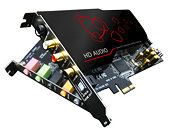- Joined
- Oct 9, 2007
- Messages
- 47,300 (7.53/day)
- Location
- Hyderabad, India
| System Name | RBMK-1000 |
|---|---|
| Processor | AMD Ryzen 7 5700G |
| Motherboard | ASUS ROG Strix B450-E Gaming |
| Cooling | DeepCool Gammax L240 V2 |
| Memory | 2x 8GB G.Skill Sniper X |
| Video Card(s) | Palit GeForce RTX 2080 SUPER GameRock |
| Storage | Western Digital Black NVMe 512GB |
| Display(s) | BenQ 1440p 60 Hz 27-inch |
| Case | Corsair Carbide 100R |
| Audio Device(s) | ASUS SupremeFX S1220A |
| Power Supply | Cooler Master MWE Gold 650W |
| Mouse | ASUS ROG Strix Impact |
| Keyboard | Gamdias Hermes E2 |
| Software | Windows 11 Pro |
Taiwanese PC audio hardware manufacturer Aim launched its flagship consumer sound card, the SC808. This full-height dual-slot (with daughterboard) sound card features PCI-Express x1 bus interface, and offers 7.1-channel analog and digital outputs. At its heart is C-Media's CMI8888, which is a native PCIe HDA controller, giving external DACs the task of handling analog outputs. The primary 2-channel headphones output is driven by a Wolfson WM8741 DAC, which offers a stellar SNR of 128 dBA. Other analog channels (center/sub, rear, sides), are handled by a C-Media CMI9882A CODEC, which offers a reasonable 100 dBA.
At the downstream of the WM8741 is the card's headphones amp circuit, featuring socketed Texas Instruments LM4562 OPAMP chips, metalized polypropylene capacitors, and a swappable pre-amp stage. The main PCB of the card holds a 6.3 mm stereo headphones jack, left and right RCA line-outs, 7.1-channel coaxial, and optical/TOSLINK SPDIF outputs. The other multi-channel analog outs are wired out by a header and ribbon cable to the daughterboard, which holds color-coded 3.5 mm jacks to all the channels. All audio portions of the card feature electrolytic capacitors (except the OPAMP stages, which feature MP caps), only the electrical/VRM portion of the card features conductive polymer (solid-state) capacitors. The card draws power from a 4-pin Molex power connector. On the software side of things, the driver provider is C-Media, with its reference Xear3D control panel. The card supports Windows 8. Slated for an April 24th launch in Japan, it's expected to be priced at 12,000¥ (US $112). Given its hardware, that's a reasonable price.

View at TechPowerUp Main Site
At the downstream of the WM8741 is the card's headphones amp circuit, featuring socketed Texas Instruments LM4562 OPAMP chips, metalized polypropylene capacitors, and a swappable pre-amp stage. The main PCB of the card holds a 6.3 mm stereo headphones jack, left and right RCA line-outs, 7.1-channel coaxial, and optical/TOSLINK SPDIF outputs. The other multi-channel analog outs are wired out by a header and ribbon cable to the daughterboard, which holds color-coded 3.5 mm jacks to all the channels. All audio portions of the card feature electrolytic capacitors (except the OPAMP stages, which feature MP caps), only the electrical/VRM portion of the card features conductive polymer (solid-state) capacitors. The card draws power from a 4-pin Molex power connector. On the software side of things, the driver provider is C-Media, with its reference Xear3D control panel. The card supports Windows 8. Slated for an April 24th launch in Japan, it's expected to be priced at 12,000¥ (US $112). Given its hardware, that's a reasonable price.

View at TechPowerUp Main Site





